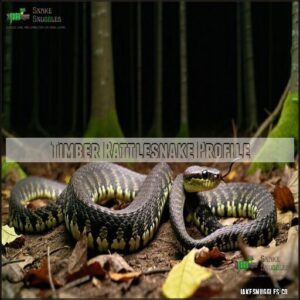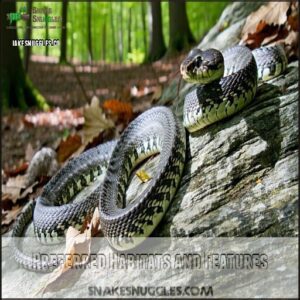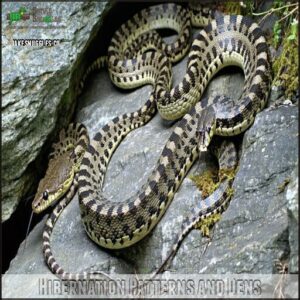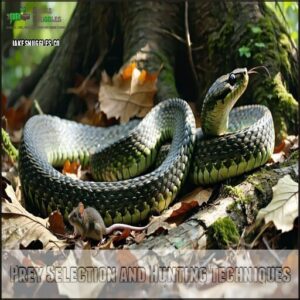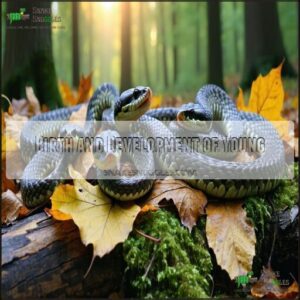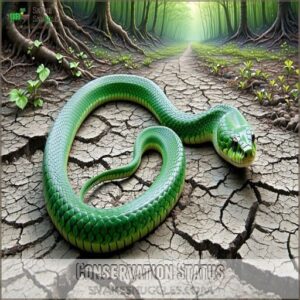This site is supported by our readers. We may earn a commission, at no cost to you, if you purchase through links.
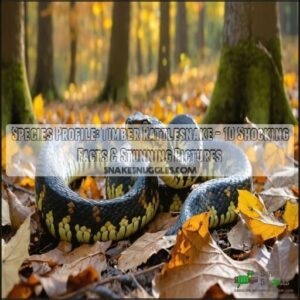 The timber rattlesnake, a master of camouflage and patience, is a venomous snake native to North America.
The timber rattlesnake, a master of camouflage and patience, is a venomous snake native to North America.
You’ll find it in forests, rocky outcrops, and hillsides, often blending perfectly into its surroundings with its tan, brown, or gray scales marked by dark, zigzag bands.
These snakes can grow up to 5 feet long and sport a distinctive rattle at the tail’s end, which warns predators to back off.
Despite their fearsome reputation, they’re shy and prefer avoiding humans.
They hunt rodents and birds using heat-sensing pits and venom.
Curious about their unique hibernation dens or conservation challenges? There’s more to uncover!
Table Of Contents
- Key Takeaways
- Timber Rattlesnake Profile
- Habitat and Behavior
- Diet and Reproduction
- Conservation Status
- Frequently Asked Questions (FAQs)
- What is a timber rattlesnake?
- Is a timber rattlesnake poisonous?
- How common is a timber rattlesnake?
- How big do timber rattlesnakes get?
- What snakes look like timber rattlesnakes?
- How many young does a timber rattlesnake have?
- What are some interesting facts about timber rattlesnakes?
- What are the physical characteristics of a timber rattlesnake?
- What are 5 interesting facts about rattlesnakes?
- How long do you have if a timber rattlesnake bites you?
- Conclusion
Key Takeaways
- You’ll find timber rattlesnakes in forests, rocky ridges, and wetlands across the eastern U.S., where they avoid humans and rely on camouflage for survival.
- They’re venomous but shy, using their heat-sensing pits and venom to hunt rodents and birds while warning predators with their rattle.
- Females give birth to live young every 2-3 years, with neonates born equipped with venom and a single rattle segment.
- Habitat loss and human threats have made them endangered or threatened in many states, despite their critical role in controlling rodent populations.
Timber Rattlesnake Profile
You’ll meet the timber rattlesnake (Crotalus horridus), a venomous pit viper with distinctive black bands across its brown-scaled body and a famous rattle on its tail.
This impressive reptile, reaching up to 5 feet in length and weighing between 1-3 pounds, makes its home throughout the eastern United States in forests, rocky ridges, and woodland areas.
It hunts mostly at night.
Scientific Classification
In the intricate world of snake taxonomy, you’ll find the Timber Rattlesnake classified as Crotalus horridus.
This venomous serpent belongs to Kingdom Animalia, Phylum Chordata, Class Reptilia, Order Squamata, and Family Viperidae.
The Latin name offers a window into its nature—"Crotalus" (bell or rattle) and "horridus" (dreadful)—perfectly capturing its characteristic warning sound.
Taxonomic history shows some naming disputes regarding subspecies, particularly with its alternate name, Canebrake rattlesnake.
Physical Characteristics
You’ll immediately recognize a timber rattlesnake by its distinctive appearance.
These snakes typically measure 3-5 feet long, weighing 1-3 pounds, with some giants reaching 6 feet.
Their triangular head, vertical pupils, and heat-sensing pits between eye and nostril are key identifiers.
Scale morphology includes keeled scales in 21-26 rows, while color variation ranges from yellowish-brown to nearly black, with dark zigzag bands across the body.
Habitat and Distribution
You’ll find timber rattlesnakes throughout the eastern United States, from southern New Hampshire to northern Florida and westward to Texas and Minnesota.
They’re homebodies who prefer deciduous forests, rocky ridges, and wetlands—places where humans don’t often tread.
Unlike some rattlers, these snakes avoid urban areas, sticking to woodland areas where habitat fragmentation and climate change increasingly threaten their natural range.
Body Length and Weight
The timber rattlesnake’s size might surprise you when encountered in the wild.
You’ll typically find adults measuring between 3-5 feet in length and weighing 1-3 pounds, though weight variation depends largely on recent meals and season.
- Maximum length can reach an impressive 6 feet in exceptional specimens
- Sexual dimorphism exists, with males generally growing larger than females
- Average size correlates with geographic location, with northern populations typically smaller, which is an important factor to consider when discussing the timber rattlesnake’s size and geographic location.
Color Patterns and Scales
You’ll notice that timber rattlesnakes display remarkable color variation throughout their range.
Their dorsal scales are keeled and arranged in 21-26 rows, creating a distinctive texture.
Most specimens feature dark zig-zag bands against backgrounds ranging from golden yellow to entirely black.
This pattern development provides excellent camouflage strategies in woodland environments.
During the shedding process, their coloration may temporarily dull before revealing refreshed snake scales underneath, which is a key part of their shedding process.
Head Shape and Rattle
Beyond those stunning scales, you’ll notice the timber rattlesnake’s distinctive triangular head shape—a telltale sign of venomous species.
This broad, flat head houses specialized venom glands and sensory pits between the eyes and nostrils that detect heat from prey.
At the opposite end, the famous rattle grows with each shed, adding segments that create that spine-chilling warning sound we’ve all learned to respect.
Other rattlesnakes, such as the Mojave rattlesnake, also possess heat-sensing pits to aid in hunting.
Habitat and Behavior
You’ll find timber rattlesnakes stretching from New Hampshire to Florida, where they’ve made themselves at home in rocky forests, swampy lowlands, and secluded mountain ridges.
During winter, they’ll gather with other snakes in communal dens, sometimes sharing their rocky refuges with copperheads and black rat snakes as they wait out the cold months, often in areas with specific conditions that support their survival, such as rocky forests.
Geographic Range in US
Currently, you’ll find the timber rattlesnake throughout the eastern United States, from northern Florida to New Hampshire, and westward to Texas and Minnesota.
They’re regionally extinct in Canada and have disappeared from Maine. This snake’s range follows the Appalachian Mountains, with isolated populations showing unique regional variations.
Climate impact and habitat loss have reduced their distribution, earning them endangered status in several northern states like Vermont and Massachusetts.
Their distribution is affected by rattlesnake habitat preferences, influencing where they can thrive in their natural range with unique regional variations.
Preferred Habitats and Features
Within the timber rattlesnake range, you’ll find these elusive serpents thriving in very specific habitats.
Their ideal terrain includes deciduous hardwood forests, rocky outcrops, and wetlands with moderate moisture levels.
Three features that make perfect rattlesnake habitat include:
- South-facing slopes that capture essential warmth
- Rocky ledges offering protection from predators
- Proximity to abundant prey sources like mice and chipmunks.
Creating enriching habitats often involves specialized habitat decor.
Hibernation Patterns and Dens
Looking for a warm place to survive freezing temperatures, Timber Rattlesnakes gather in communal dens called hibernacula.
These winter brumation sites often host not just rattlers but also copperheads and Eastern racers.
You’ll find these snake dens in rocky crevices on south-facing slopes.
The brumation duration typically spans September to May, depending on weather, with the snakes showing remarkable loyalty to their winter homes.
They’re loyal to their winter homes, with den fidelity passed down to offspring through scent trails.
Diet and Reproduction
You’ll be amazed by how timber rattlesnakes use their heat-sensing pits to hunt rodents, birds, and other small mammals before swallowing them whole.
Timber rattlesnakes rely on heat-sensing pits to strike with precision, immobilizing prey before swallowing it whole.
Female rattlers bring new life into the world every 2-3 years, giving birth to live young after an unusual "combat dance" between competing males determines who gets to mate.
Prey Selection and Hunting Techniques
In search of their next meal, timber rattlesnakes rely on ambush tactics rather than active pursuit.
You’ll find these patient predators coiled beside fallen logs, perfectly still for hours while waiting for prey.
Their diet consists mainly of rodents and small mammals, with occasional birds and garter snakes.
Using heat-sensitive pits, they detect warm-blooded prey size before striking with remarkable accuracy, injecting venom to immobilize dinner.
These snakes are Nebraska’s largest rattlesnake, growing up to 60 inches long.
Mating and Breeding Habits
When timber rattlesnakes emerge from hibernation in spring, they begin their fascinating mating rituals.
You’ll find these snakes engaging in unique reproductive behaviors:
- Males perform an elaborate "combat dance" to compete for females
- Mating season typically occurs between April and October
- Females have a 2-3 year litter interval between pregnancies
- Snakes reach maturity age at different times (males around 5, females around 8)
- Pregnant females exhibit specific basking behavior to aid embryo development
During mating, the male timber rattlesnake will use two hemipenes to inseminate the female.
Birth and Development of Young
After mating, the timber rattlesnake’s reproduction journey continues with its fascinating birth process. These snakes are ovoviviparous, meaning you’ll find females giving birth to live young rather than laying eggs.
A typical litter includes 7-9 neonates, each equipped with fangs and venom from day one. Young snakes measure 8-17 inches with a single rattle button.
Males reach sexual maturity at 3-5 years, while females take 4-10 years before becoming gravid.
Conservation Status
You’ll be surprised to learn that timber rattlesnakes are now listed as threatened or endangered in many states where they once thrived.
Their populations have declined dramatically due to habitat loss, intentional killing, and slow reproduction rates.
Making conservation efforts essential for this misunderstood reptile, especially due to their slow reproduction rates, is crucial for their survival.
Regional Population Trends and Threats
Standing on the brink of extinction throughout New England, timber rattlesnakes have disappeared entirely from Maine and Rhode Island.
Timber rattlesnakes face extinction in New England, vanishing completely from Maine and Rhode Island due to habitat loss and human threats.
You’ll find these serpents facing steep population declines, with habitat loss and human persecution as their biggest threats.
Once widespread across eastern North America, they now survive in small, isolated pockets.
Conservation efforts include capture and relocation programs to reduce human-wildlife conflict, but their future remains uncertain without expanded protection.
Supporting rattlesnake preservation initiatives can help these vulnerable creatures.
Protected Status in Different States
Widespread population declines have prompted varied legal protections for timber rattlesnakes across their range.
You’ll find them fully protected in New Jersey, Connecticut, and Vermont where they’re endangered, with population reductions reaching 66% in some areas.
They’re listed as threatened in Pennsylvania, New York, and Texas.
Maine and Rhode Island have lost their populations entirely, while states like Nebraska only offer protection when the snakes don’t threaten humans or livestock.
IUCN Red List Classification
Beyond state protections, you’ll find the timber rattlesnake listed as "Least Concern" on the IUCN Red List.
Don’t let this classification fool you though! Their population viability remains threatened by habitat loss and climate impact.
Conservation efforts focus on preserving remaining populations, with many experts suggesting the threat level should be higher.
Snake conservation status varies by region, with some populations nearing endangered species criteria despite the overall classification.
Notably, some snakes like the eastern kingsnake adapt to urban environments.
Frequently Asked Questions (FAQs)
What is a timber rattlesnake?
Picture a snake blending into the forest floor, its striped body coiled and rattle poised.
That’s the timber rattlesnake—a venomous viper, expert ambusher, and heat-sensing predator found in the eastern United States’ woodlands.
Is a timber rattlesnake poisonous?
The timber rattlesnake isn’t “poisonous” but venomous.
Its venom, delivered through fangs, immobilizes prey and aids digestion.
Don’t worry; it prefers avoiding humans and only strikes if threatened.
Respect its space, and you’re good!
How common is a timber rattlesnake?
You won’t stumble across timber rattlesnakes every day, but they’re not exactly rare either.
They’re scattered across the eastern U.S., often sticking to forests, rocky ridges, or swamps, avoiding people whenever possible.
How big do timber rattlesnakes get?
Imagine spotting a six-foot rattlesnake—it’s rare but possible!
Most timber rattlesnakes average 3-5 feet long, with hefty males reaching up to 6 feet.
Their size depends on food, habitat, and age.
What snakes look like timber rattlesnakes?
Snakes like the eastern hognose, milk snake, or northern water snake can resemble timber rattlesnakes.
Their similar patterns or colors may confuse you, but they lack rattles and the triangular head shape of rattlers.
How many young does a timber rattlesnake have?
A female timber rattlesnake typically gives birth to 6-10 live young every 2-3 years.
These tiny snakes, called neonates, are born with venom and a small rattle segment, ready to face the world.
What are some interesting facts about timber rattlesnakes?
Timber rattlesnakes can live up to 30 years, grow over six feet long, and use heat-sensing pits to hunt prey in the dark.
They’re surprisingly shy, often avoiding humans unless provoked.
Their rattles? Built-in alarms!
What are the physical characteristics of a timber rattlesnake?
You’ll notice timber rattlesnakes have a thick, muscular body with dark zig-zag bands on brown scales.
Their triangular head, vertical pupils, and black-tipped tail with a rattle make them unmistakable and fascinatingly unique.
What are 5 interesting facts about rattlesnakes?
They say curiosity killed the cat, but it might’ve been a rattlesnake.
These reptiles sense heat, shed skin to grow their rattle, hibernate with other snakes, ambush prey, and live up to 30 years.
How long do you have if a timber rattlesnake bites you?
If a timber rattlesnake bites you, you’ve got hours, not minutes, to get medical attention.
Its venom is dangerous but rarely instantly fatal.
Stay calm, limit movement, and seek antivenom treatment immediately to stay safe.
Conclusion
Picture the timber rattlesnake as nature’s silent guardian, quietly patrolling its forest home.
This species, with its impressive camouflage and unique rattle, displays both beauty and function.
From heat-sensing pits to its role in controlling rodent populations, it’s a key player in the ecosystem.
Though often misunderstood, this shy snake avoids conflict with humans.
By learning more about the species profile timber rattlesnake with pictures and facts, you’ll appreciate its value in nature’s delicate balance.
- https://www.iucnredlist.org/species/64318/12765920
- https://www.merriam-webster.com/dictionary/taxonomies
- https://outdoornebraska.gov/learn/nebraska-wildlife/nebraska-animals/reptiles-and-amphibians/reptiles-of-nebraska/snakes-of-nebraska/timber-rattlesnake/
- https://nationalzoo.si.edu/animals/timber-rattlesnake
- https://digitalcommons.odu.edu/cgi/viewcontent.cgi?article=1311&context=biology_fac_pubs

